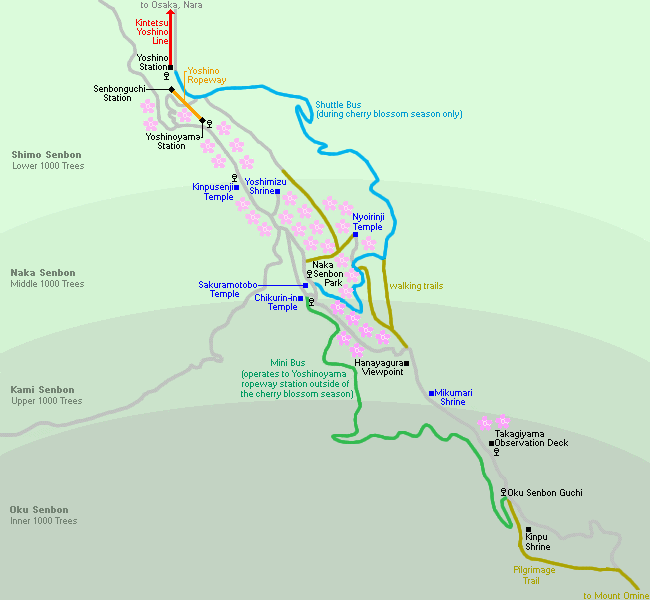Mount Yoshinoyama

Mount Yoshino (吉野山, Yoshinoyama) in Nara Prefecture has been Japan's most famous cherry blossom spot for many centuries. It is said that the first trees were planted along its slopes more than 1300 years ago, and today the mountain is covered by approximately 30,000 cherry trees of many different varieties, especially of the Yamazakura variety.
Rather than a free standing mountain, Yoshinoyama is a north-facing mountain slope. It is divided into four areas: the Shimo Senbon (lower 1000 trees) at the base of the mountain, Naka Senbon (middle 1000 trees), Kami Senbon (upper 1000 trees) and Oku Senbon (inner 1000 trees) at the top of the mountain. Visitors can enjoy the cherry trees as they ascend the mountain, passing Yoshino's touristy town with its various temples and shrines, and enjoying hanami in the parks and viewpoints along the way.

Yoshinoyama's cherry blossoms typically start opening in late March or early April and reach full bloom around early to mid April. Because of the range of elevation, the blooming season is staggered by a couple of days between the Shimo (lower), Naka (middle) and Kami (upper) Senbon areas as the blossom front gradually moves up the mountain. The trees in the Oku Senbon area open considerably later. Be warned that depending on the weather, the starting date and length of the season can vary quite a bit from year to year.
The Shimo Senbon (lower) area encompasses the base of the mountain around Yoshino Station and the lower part of the town. The Yoshino Ropeway bypasses the steep ascent between the station and the town, but waiting times for the ropeway can get very long during the peak of the season. Lots of cherry trees are planted along the road up to the town, making the ascent on foot an attractive alternative to the ropeway.

The Naka Senbon (middle) area covers the rest of the town along the ridge of the mountain. This is where the majority of Yoshino's accommodations, shops, restaurants, temples and shrines are found, including Kinpusenji Temple and Yoshimizu Shrine. The view up the mountain from Yoshimizu Shrine is particularly famous.
Towards the top of the Naka Senbon area lies the Naka Senbon Park, one of the most attractive spots for holding hanami picnics under the trees. The park spans several small hills that are covered by cherry trees and offer views onto even more cherry trees. Especially in good weather, the atmosphere here is delightful.

Further up the mountain in the Kami Senbon (upper) area, the town begins to thin out. Kami Senbon tends to be a little less crowded and slightly quieter than the lower parts of the mountain, and several small parks provide nice places to take a break. The most famous panoramic view of Yoshinoyama can be enjoyed from the Hanayagura View Point, about one hour on foot from the upper ropeway station.
The Oku Senbon area has by far the fewest cherry trees and does not offer any views of the cherry tree covered mountain slopes. However, the trees here bloom about a week behind the rest of Yoshinoyama, so it may be worth visiting if you are too late to see the blossoms along the lower slopes. The best hanami spot in the Oku Senbon area is the Takagiyama Observation Deck roughly a 90 minute walk from the ropeway station.

Getting there and around
During the cherry blossom season:
Shuttle buses operate between Yoshino Station and the Naka Senbon area near Chikurin-in Temple from late March to late April (March 23 to April 20 and April 26 to May 6, 2025; 500 yen one way, 2 buses/hour). From the Naka Senbon area near Chikurin-in Temple, mini buses operate further to the Oku Senbon area of Yoshinoyama until early May (March 22 to May 6, 2025; 15 minutes, 400 yen one way, 1-2 buses/hour).
Most of the Shimo and Naka Senbon areas are closed to car traffic from 8:00 to 21:00, while cars are allowed in the Kami Senbon area except on particularly busy days when that area is closed to cars, as well.
Outside of the cherry blossom season:
Mini buses operate hourly from the upper ropeway station (Yoshinoyama Station) through the town into the Oku Senbon area on weekends outside of winter. The fare depends on the distance traveled and ranges between 170 and 500 yen. The ride from the upper ropeway station to Oku Senbon takes twenty minutes. The buses do not operate on weekdays and from early December to early March.
How to get to and around Yoshino

Questions? Ask in our forum.


